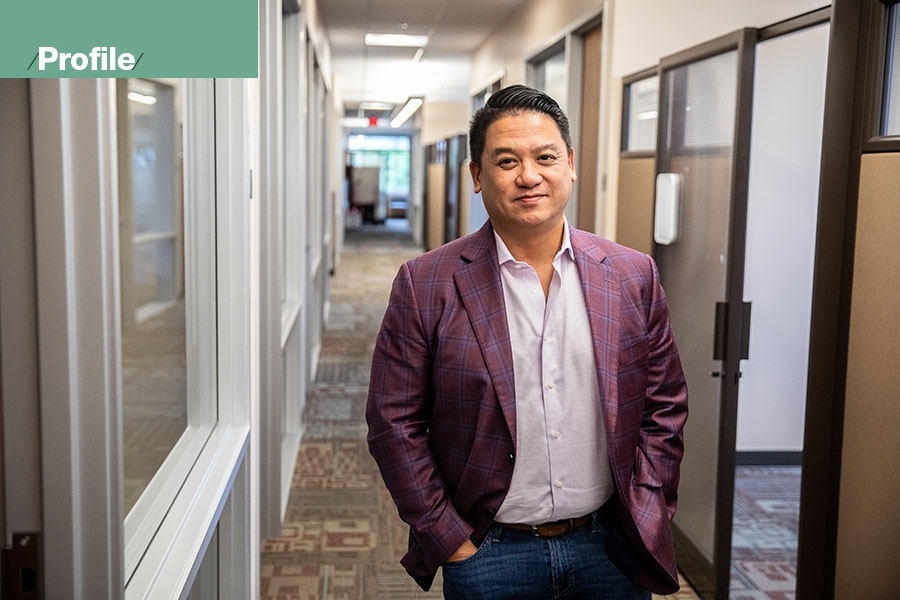A Eugene-based company aims to be ‘Uber for nursing’ — a win-win for understaffed hospitals and for nurses looking to make extra money. But skeptics say hospitals’ staffing problems run deeper.
One night in 2018, Israel Angeles went out to meet a friend for dinner.
His friend, Angeles says, showed up late and “a little irritated.”
“He says, ‘Sorry for being late, but my circulator has called in sick two days in a row,’” Angeles tells Oregon Business. (A circulator is a nurse who manages the flow of patients and materials in an operating suite.)
There was no easy way to replace the nurse at short notice, Angeles says. And over dinner, the two hatched an idea.
“This was 2018, and Uber and Lyft were just taking off, and as we’re talking, he says, ‘Gosh, I wish there was something like an Uber for nurses,’” says Angeles, an Army veteran whose resume includes a series of roles in medical equipment sales. “I was finishing up my MBA at the time and started thinking, ‘Uber for nurses? Wow. That’s a great concept,’ and I started researching it.”
The result was FleetNurse, an app that offers access to health care workers who can come in for shifts at a moment’s notice. Since its launch in 2019, the Eugene-based startup has seen exponential growth and expansion during the COVID-19 pandemic. (Despite the name, the company also employs thousands of nurses, medical and surgical technicians, nursing assistants, and other health care workers.) In May private-equity firm HCAP Partners announced a minority investment in FleetNurse.
HCAP Principal Nicolas Lopez joined FleetNurse’s board as part of the deal.
In a statement following the announcement, Lopez said the decision to invest was based around the company “using the same technology that disrupted and optimized ride sharing, vacation rentals and many other segments of the modern economy,” and that FleetNurse had “created a powerful software solution to efficiently match high-quality nurses to facilities in both the acute and post-acute markets.”
Initially, FleetNurse operated only in Eugene, where the company is based. The app is now available in eight states and has more than 2,000 nurses registered in Oregon and 32,000 nationwide. The app has continued to grow amid the ongoing health care worker shortage. According to Angeles, the company more than doubled its revenue between 2020 and 2021.
Angeles, now FleetNurse’s CEO, says the staffing challenges hospitals have faced during COVID-19 made FleetNurse a godsend for understaffed facilities. But the app has also been valuable to health care workers who faced layoffs during the early part of the pandemic, as well as those who want extra money or more flexible hours.
Lynne Morin, a surgical technologist at McKenzie-Willamette Medical Center in Springfield, wasn’t sure how she was going to make ends meet after her hospital canceled noncritical surgeries and furloughed several staff members. Then a colleague told her about FleetNurse.
Most hospital systems have their own call sheet of per-diem workers; FleetNurse connects hospitals and other health care facilities to a much larger pool of applicants, with skill sets that can satisfy a wider range of staffing needs. The app also boasts a streamlined registration process that matches employee credentials with care facilities’ needs. As long as they are willing to make the drive and have the right credentials, health care workers on the app can work at any registered FleetNurse hospital in the state.
Morin says joining FleetNurse offered her a crucial source of income during an uncertain time. During lockdown, Morin was scheduled to work in the operating room at McKenzie-Willamette one day a week, with the option of working in other areas of the hospital when available. Since these “floater” shifts were in high demand, Morin used FleetNurse to give her fellow technicians a better chance of getting the coveted hours.
“It really helped me out a lot, because my hospital shut down [nonessential surgeries], but a couple of surgery centers did not,” says Morin. “I was able to go through FleetNurse and get staffed at a surgery center, so it really helped during COVID-19.”
Like Uber and Lyft drivers — not to mention other “gig economy” workers, like those who deliver food and groceries through apps — health care workers join the platform for a variety of financial reasons.
“We have moms, we have retirees, we have people who are working-full time, we have RNs who just don’t want to work on a fixed schedule,” says the bubbly Angeles, who can barely contain his enthusiasm when talking about the company’s success. “What we did was create a technology where nurses can upload the documents they need to without having to scan something or fax something. Everything can be done on a mobile device. So that sped up the credentialing process. It didn’t change the process; it just made it more efficient.”
Given that Angeles cites Uber as an inspiration, it’s worth noting that the ride-share company has campaigned aggressively to keep its drivers from being categorized as employees, thus preventing Uber and Lyft from having to provide health benefits. Angeles says the ideal situation is that health care workers on the app have another job and use FleetNurse to make extra money. But, he added, the company is looking into granting health care benefits for employees who use the app as their primary source of income.
Kevin Mealy, communications manager for the Oregon Nurses Association, expressed some concern that FleetNurse workers may not be represented by any union. Angeles insists the app could not, and would not, be used as a “union-buster,” noting that hospitals have to pay a premium for each of FleetNurse’s on-demand workers, and that it would take nearly all the registered nurses on the app to act as relief staff at a large hospital like Providence St. Vincent, whose nurses voted to strike shortly before this issue went into production.
But Mealy also warns that an app like FleetNurse could bring about the more serious consequence of serving as a Band-Aid to fix what he sees as an overprivatized system.
“FleetNurse is certainly thinking of health care as a private aspect of the economy,” Mealy says. “And I would say that health care needs to be thought of more as a public resource and hospitals as a community resource, which run 24/7, 365 days a year, and always need to be staffed. They receive a great amount of public dollars via Medicare and Medicaid, and by being literal nonprofits that don’t pay taxes.
“I think the promise of sort of an Uber or Lyft for nursing is an interesting idea, but when we think about health care, it’s more of a community resource that needs to be provided to everyone, as opposed to an optional resource that could be more transactional,” Mealy adds.
Mealy is also skeptical of the quality of care health care workers can deliver when they aren’t as familiar with a particular hospital’s protocols. The way he sees it, health care teams function better with per-diem replacement workers who know hospital protocol as intimately as the full-time staff. Even if a replacement worker has the skills necessary to work in a specialized environment like an ICU, a health care system could be so different in their responses to an emergency event that a FleetNurse employee could become a liability.
While the app makes verifying credentials easy for hospitals, every health care facility has its own unique set of standards and protocols new employees must learn to keep operations running smoothly. Learning these standards and practices requires two to three days of in-person attendance — something the app hasn’t been able to streamline just yet.
But Angeles says he’s working on it.
“There’s a company in Bend we’re looking at that does virtual reality,” Angeles says. “We’re looking to create a training course for one of the centers we work with to do the orientation for those nurses based on the standards of the hospital, all via VR. They could tour the hospital without physically going into the hospital. That’s another way we’re using technology to streamline the process.”
Wage contracts are negotiated separately between FleetNurse and every health care system with which it partners. Each worker receives a premium for being on the app, but Morin says she only made a few dollars an hour more working for FleetNurse than she does at her regular job.
Morin’s employer is once again performing nonemergency surgeries, and she says she is not working for FleetNurse as much as she was during the height of the pandemic. But she’s grateful for the lifeline FleetNurse provided for her during the pandemic, and says she will remain part of the app for the foreseeable future.
“I’m still signed up. If I ever had the time again, I will let them know for sure,” she says.
Mealy says the idea of an app that can act as Uber or Lyft for nursing is “interesting,” and that he appreciates what the company is trying to do. But to his view, the problems it’s trying to solve go deeper than day-to-day staffing.
“I don’t fault FleetNurse for trying to innovate its way out of a health care worker shortage, but nurses shouldn’t need a side hustle to do their job of making patients healthy and happy and making ends meet,” Mealy says. “Hospitals are extraordinarily profitable nonprofits, and they should first look internally at how they can build that cohesive health care team rather than rely on someone who’s there one day and gone the next.”
To subscribe to Oregon Business, click here.









